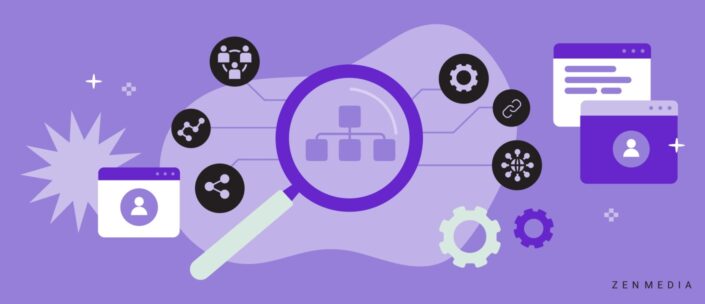Link building is a fundamental component of any comprehensive B2B SEO strategy, and internal linking is crucial to its success. While external backlinks from authoritative websites contribute to your website’s credibility and visibility, internal links establish the foundation of your site’s link profile.
Internal linking strengthens the structure and connectivity of your website. It serves as the connective tissue that weaves together your website’s various pages and sections, facilitating seamless navigation, improving user experience, and bolstering search-engine visibility. Internal linking is not just a mere technicality but a strategic endeavor that requires a deep understanding of your content, audience, and goals. By strategically interlinking relevant pages within your site, you amplify the authority and value of each page, ultimately enhancing the overall link profile.
Choosing the most appropriate anchor text, aligning it with the linked content, and incorporating relevant keywords will improve search engine rankings and targeted organic traffic. Careful attention to readability, user experience, and a balanced linking profile ensures that your internal links are search engine-friendly and resonate with your audience.
Avoiding common pitfalls such as over-optimization and keyword stuffing safeguards your website against penalties and demonstrates authenticity and trustworthiness. By striving for a natural and organic approach to internal linking, you provide users with a valuable and engaging browsing experience, encouraging them to explore more of your content and increasing the likelihood of conversions.
Harnessing the power of internal linking is not just about creating pathways within your website—it’s about driving tangible SEO success and reaping the rewards of increased visibility, organic rankings, and improved user engagement.
Benefits of Internal Linking
Enhanced “crawlability” and indexation
Internal links serve as guideposts for search engine crawlers, leading them to discover and index your website’s valuable content. When you place internal links throughout your site, you ensure that search engines can easily navigate and understand the depth and breadth of your website. This, in turn, enhances “crawlability” and indexation, increasing the likelihood of your pages being included in search engine results.
Strengthened topical relevance and authority
Internal links allow you to establish thematic connections between related pages, signaling to search engines your website’s topical relevance and authority. By interlinking content around specific topics or keywords, you reinforce your website’s expertise and create a comprehensive network of information. This interconnectedness not only benefits search engine rankings but also provides users with a seamless browsing experience, allowing them to explore different facets of your expertise.
Improved user experience and engagement
Thoughtfully placed internal links provide users with a roadmap to explore additional relevant content on your website. By guiding them from one page to another, you keep them engaged, encourage longer session durations, and reduce bounce rates. Internal links entice users to delve deeper into your website and discover its wealth of valuable information. Improving the user experience fosters trust and credibility and creates a higher likelihood of conversions or return visits.
Amplified keyword rankings and organic traffic
A well-executed internal linking strategy can significantly impact keyword rankings and organic traffic. By incorporating relevant keywords in your anchor text and strategically linking to pages optimized for those keywords, you send powerful signals to search engines about the content’s relevance and authority. This, in turn, increases the likelihood of ranking higher for those keywords and driving targeted organic traffic to your website.
Seamless synergy with external link building
Internal linking and external link building go hand in hand, creating a powerful synergy that fuels SEO success. Internal links provide a strong foundation for your website’s link profile, demonstrating the interconnectedness and value of your content. Internal linking can attract external links from other reputable websites, further enhancing your website’s authority and visibility in search engine rankings.
By understanding and leveraging the power of internal linking, you position your website as a reliable resource, attract targeted organic traffic, and establish a strong foothold in the competitive digital landscape.
Incorporating Internal Linking in Your SEO Strategy
When developing your comprehensive SEO strategy, consider the following aspects related to internal linking:
- Content Optimization: Incorporate internal links within your content to guide users toward relevant and related pages. By interconnecting your content, you create a cohesive user experience that encourages exploration and engagement.
- Site Architecture: Structure your website in a logical and organized manner, making it easy for users and search engines to navigate. Integrate internal links strategically to facilitate a seamless journey across different sections and categories.
- Keyword Targeting: Use anchor text strategically to incorporate target keywords within your internal links. This optimization technique signals to search engines the relevance and importance of the linked pages, potentially boosting their rankings.
Maximizing the Benefits of Internal Linking for SEO Optimization
Internal linking offers several benefits for SEO optimization. By maximizing these benefits, you can elevate your website’s visibility and rankings. Consider the following strategies:
- Linking to High-Value Pages: Identify your website’s most valuable and informative pages and ensure they receive ample internal links. By linking to these pages from other relevant content, you amplify their visibility and authority, signaling their importance to search engines.
- Deep Linking: Don’t limit your internal links to just the homepage or top-level pages. Incorporate deep links that direct users and search engine crawlers to specific subpages or articles, spreading link equity and increasing visibility across your site.
- Contextual Relevance: When selecting anchor text for your internal links, prioritize contextual relevance. Choose anchor text that accurately reflects the linked page’s content, providing users and search engines with clear indications of what they can expect when they click on the link.
Tracking and Monitoring the Effectiveness of Internal Links
You must track and monitor the effectiveness of your internal links to get any value out of an internal linking strategy. Regularly analyze metrics such as click-through rates, time on page, and bounce rates to assess user engagement and the impact of your internal links.
By monitoring the performance of your internal links, you can identify areas for improvement, refine your linking strategy, and optimize the user experience. Use web analytics tools and data-driven insights to gain valuable insights into how your internal links contribute to the overall SEO performance of your website.
Incorporating internal linking into your SEO strategy is a powerful way to enhance your website’s visibility, improve user experience, and strengthen your link profile. By leveraging the interconnectivity of your content, you create a cohesive and authoritative online presence that makes your brand stand out.
Ready to level up your internal linking strategy? Reach out today.







